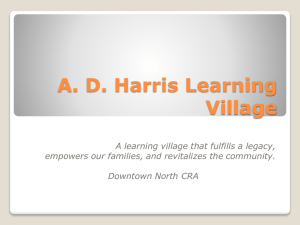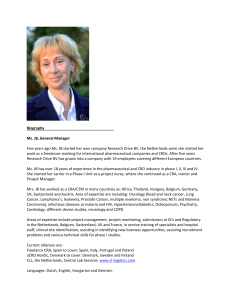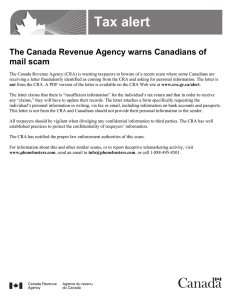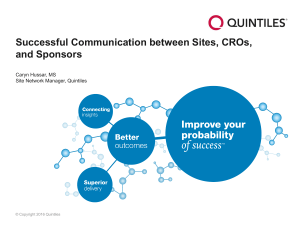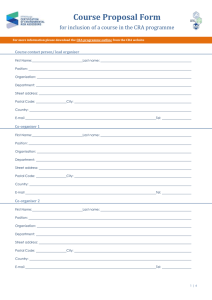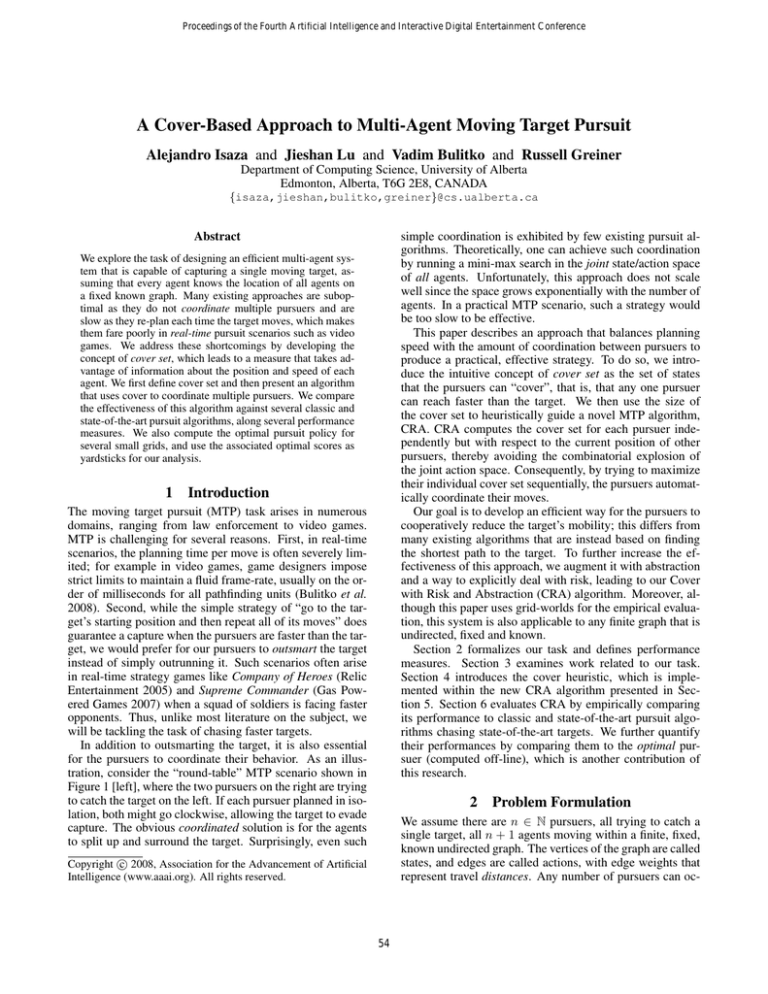
Proceedings of the Fourth Artificial Intelligence and Interactive Digital Entertainment Conference
A Cover-Based Approach to Multi-Agent Moving Target Pursuit
Alejandro Isaza and Jieshan Lu and Vadim Bulitko and Russell Greiner
Department of Computing Science, University of Alberta
Edmonton, Alberta, T6G 2E8, CANADA
{isaza,jieshan,bulitko,greiner}@cs.ualberta.ca
Abstract
simple coordination is exhibited by few existing pursuit algorithms. Theoretically, one can achieve such coordination
by running a mini-max search in the joint state/action space
of all agents. Unfortunately, this approach does not scale
well since the space grows exponentially with the number of
agents. In a practical MTP scenario, such a strategy would
be too slow to be effective.
This paper describes an approach that balances planning
speed with the amount of coordination between pursuers to
produce a practical, effective strategy. To do so, we introduce the intuitive concept of cover set as the set of states
that the pursuers can “cover”, that is, that any one pursuer
can reach faster than the target. We then use the size of
the cover set to heuristically guide a novel MTP algorithm,
CRA. CRA computes the cover set for each pursuer independently but with respect to the current position of other
pursuers, thereby avoiding the combinatorial explosion of
the joint action space. Consequently, by trying to maximize
their individual cover set sequentially, the pursuers automatically coordinate their moves.
Our goal is to develop an efficient way for the pursuers to
cooperatively reduce the target’s mobility; this differs from
many existing algorithms that are instead based on finding
the shortest path to the target. To further increase the effectiveness of this approach, we augment it with abstraction
and a way to explicitly deal with risk, leading to our Cover
with Risk and Abstraction (CRA) algorithm. Moreover, although this paper uses grid-worlds for the empirical evaluation, this system is also applicable to any finite graph that is
undirected, fixed and known.
Section 2 formalizes our task and defines performance
measures. Section 3 examines work related to our task.
Section 4 introduces the cover heuristic, which is implemented within the new CRA algorithm presented in Section 5. Section 6 evaluates CRA by empirically comparing
its performance to classic and state-of-the-art pursuit algorithms chasing state-of-the-art targets. We further quantify
their performances by comparing them to the optimal pursuer (computed off-line), which is another contribution of
this research.
We explore the task of designing an efficient multi-agent system that is capable of capturing a single moving target, assuming that every agent knows the location of all agents on
a fixed known graph. Many existing approaches are suboptimal as they do not coordinate multiple pursuers and are
slow as they re-plan each time the target moves, which makes
them fare poorly in real-time pursuit scenarios such as video
games. We address these shortcomings by developing the
concept of cover set, which leads to a measure that takes advantage of information about the position and speed of each
agent. We first define cover set and then present an algorithm
that uses cover to coordinate multiple pursuers. We compare
the effectiveness of this algorithm against several classic and
state-of-the-art pursuit algorithms, along several performance
measures. We also compute the optimal pursuit policy for
several small grids, and use the associated optimal scores as
yardsticks for our analysis.
1
Introduction
The moving target pursuit (MTP) task arises in numerous
domains, ranging from law enforcement to video games.
MTP is challenging for several reasons. First, in real-time
scenarios, the planning time per move is often severely limited; for example in video games, game designers impose
strict limits to maintain a fluid frame-rate, usually on the order of milliseconds for all pathfinding units (Bulitko et al.
2008). Second, while the simple strategy of “go to the target’s starting position and then repeat all of its moves” does
guarantee a capture when the pursuers are faster than the target, we would prefer for our pursuers to outsmart the target
instead of simply outrunning it. Such scenarios often arise
in real-time strategy games like Company of Heroes (Relic
Entertainment 2005) and Supreme Commander (Gas Powered Games 2007) when a squad of soldiers is facing faster
opponents. Thus, unlike most literature on the subject, we
will be tackling the task of chasing faster targets.
In addition to outsmarting the target, it is also essential
for the pursuers to coordinate their behavior. As an illustration, consider the “round-table” MTP scenario shown in
Figure 1 [left], where the two pursuers on the right are trying
to catch the target on the left. If each pursuer planned in isolation, both might go clockwise, allowing the target to evade
capture. The obvious coordinated solution is for the agents
to split up and surround the target. Surprisingly, even such
2
Problem Formulation
We assume there are n ∈ N pursuers, all trying to catch a
single target, all n + 1 agents moving within a finite, fixed,
known undirected graph. The vertices of the graph are called
states, and edges are called actions, with edge weights that
represent travel distances. Any number of pursuers can oc-
c 2008, Association for the Advancement of Artificial
Copyright Intelligence (www.aaai.org). All rights reserved.
54
cupy a single state; the game is over if a pursuer occupies
the target’s state. Traversing an edge takes an amount of
time that depends directly on the edge weight and inversely
on the agent’s speed. All agents (both target and pursuers)
know each other’s positions at all times. Furthermore, communication is free and the pursuers can share information
instantaneously. The environment is deterministic.
Each agent interleaves planning and moving, and cannot plan while moving. The simulation proceeds in the
following pseudo-parallel fashion: at simulation time t, an
agent plans its action, taking p seconds of CPU time. The
agent then takes an action, requiring m = d/s seconds
of simulation time, where d is the edge weight and s is
the speed of the agent. The simulation time at which this
agent will be allowed to plan again is t + τ p + m where
τ is the “planning penalty” (a simulation parameter). Between times t and t + τ p + m, the other agents are allowed
to plan and move in a similar fashion. This approach allows modeling the kind of asynchronous chase scenarios
that are common in both real-life and video games. Notice that we can obtain the turn-based synchronous environment common in the literature on MTP (Ishida 1997;
Koenig, Likhachev, & Sun 2007) by setting τ = 0, s = 1
and d = 1.
For a given graph environment, a problem instance is defined by the starting positions and speeds of all the agents.
The agents traverse the graph until one of the pursuers occupies the same location as the target (interception), or until
a pre-specified amount of time elapses (timeout). The percentage of problems where the target was intercepted successfully within the time limit is called the interception rate.
The pursuers try to catch the target and minimize the interception time, defined as the earliest simulation time at which
the target’s position is the same a pursuer’s position.
For the empirical evaluation, we will assume that the
search graph is a two-dimensional rectangular grid whose
cells are either vacant or occupied by obstacles. An agent
can visit any vacant grid cell. In Figure 1 [left], the actions
for each agent are to stay (with cost d = 1), or to move in
one of the four cardinal directions, each with cost d = 1,
provided the destination cell is not occupied by an obstacle.
3
Figure 1: Left: A round-table map. The circles are the pursuers
and × is the target. The best strategy here is for the pursuers to
split; one going clockwise and the other counter-clockwise. Right:
Cover for three agents: a target T with speed 1; pursuer P1 with
speed 0.2 and pursuer P2 with speed 0.4. The dashed line represents the trajectory pursuer P2 would take, given T ’s trajectory, to
stop T from getting though between the pursuers.
information) and deliberation (to trigger an offline-search in
response to detecting a local minima). However, even the
improved MTS is still too slow to use in realistically-sized
situations.
To speed up convergence, MT-Adaptive A* adapts heuristics learned from the previous location of the target to the
target’s new location (Koenig, Likhachev, & Sun 2007).
Koenig et al. demonstrate that MT-Adaptive A* is significantly faster than both MTS and D* Lite, an incremental
search algorithm (Koenig & Likhachev 2002). Like Adaptive A* (Koenig & Likhachev 2005), MT-Adaptive A* updates heuristics using a full A* search between the current
state of the pursuer and the current state of target. The pursuer, however, requires more than a constant time per move,
and thus loses real-time performance.
As each of the aforementioned MTS-based approaches is
designed for a single pursuer, they will not coordinate multiple pursuers, instead they would drive all of the pursuers
toward the target in a way that would probably allow the target to easily escape. By contrast, we expect that an effective
MTP algorithm should instead limit the target’s mobility by
“surrounding” it.
Multiple Agent Moving Target Search (MAMTS) extends
existing real-time search agents by coordinating the multiple pursuers (Goldenberg et al. 2003). MAMTS first groups
agents by a visibility chain, and then applies a single-agent
real-time search algorithm (e.g., greedy or minimax) using
inferences about the target and the team of pursuers. Each
agent maintains a belief set about all possible locations of
both target and pursuers, and then selects a sub-goal from its
own belief set. MAMTS is the first real-time algorithm that
coordinates pursuers to limit the target’s mobility. However,
it does not exhibit the obvious “surrounding” strategy because the pursuers only coordinate when the target is out of
sight (as in Figure 1 [left]). When the target is in sight they
switch to the shortest-path search and ignore other pursuers,
thus losing the ability to minimize the target’s mobility.
Related Research
Moving Target Search (MTS) extends Learning Real-Time
A* (LRTA*) (Korf 1990) to deal with moving targets (Ishida
& Korf 1991). It is provably complete, assuming that the
pursuer is faster than the target or the target makes suboptimal moves, and that the location of the target is always
known. An MTS pursuer exploits pairwise distance heuristics to guide the search, and interleaves planning and execution. Moreover, MTS learns, as it improves its heuristic
values incrementally based on its experience. MTS achieves
real-time performance by using a constant, one-step lookahead horizon, and is thus reactive. However, MTS pursuers
can perform poorly due to their myopic planning, which
leads to thrashing behavior and loss of information (Melax
1993) when the target moves to a new location. To address
these issues, Ishida extended MTS with commitment (to restrict the pursuer to a committed goal and prevent loss of
4
The Cover Heuristic
To motivate the notion of cover, consider the task of determining whether a target can pass between two pursuers before they close the gap between them, assuming that the target will travel in a straight line. If we know which states the
55
the cover computation for each pursuer.
While this algorithm gives good results in some cases, it
has some drawbacks. First, this naive approach is slow due
to the overhead of computing cover. Another problem is
tie-breaking, especially if all possible moves have the same
cover value because the entire area is already covered. This
causes the pursuers to make uninformed moves. Finally, the
action that maximizes cover often corresponds to holding
back as, essentially, one pursuer waits for another pursuer to
catch up; however, there are situations where one of the pursuers should rush in for a capture. In light of the drawbacks
of this naive approach, our cover-based algorithm, CRA, includes two enhancements: abstraction and risk.
pursuers can reach faster than the target, then we can simply
send the pursuer to the interception; see Figure 1 [right].
This inspires the notion of cover set, which is the set of
all states that any pursuer can reach before the target; and its
complement, a target-cover set. For each state sd , suppose
that the target takes the fastest path Sd = s1 , ..., sd of distance d to reach state sd at time td . For each state sd , if there
is a pursuer that can reach sd in time td ≤ td then sd belongs
to the cover set. We will refer to the number of states in the
cover set as cover.
However, while the cover set is useful the case of Figure 1 [right], it is not provably sufficient for capture, as the
target might not maintain a straight line trajectory. Nonetheless, the concept of cover gives heuristic information about
the “catchability” of the target, given the states of target and
pursuers. For example, if the pursuers are slow, then the
cover will be small; if the target is cornered, then the cover
will be large.
A More Practical Approximation. Cover, as defined
above, is difficult to compute. Instead, we use the following (re)definition for the target-cover set: A state s is targetcovered if (1) s is the target’s current location, or (2) s is
adjacent to a state s in the target-cover set, and the target
can reach s faster than any pursuer. This suggests the algorithm appearing in Figure 2, which performs a breath-first
expansion of the cover and target-cover sets until the two
fronts meet, at which point the expansion stops. The time
complexity of the algorithm is linear in the total number of
states N .
5.1
calculateCover
1 for each agent a (with speed s(a) and type t(a) at location l ) do
2
add [location l, agent a, time t = 0]
to the priority queue q
3 end for
4 while q is not empty do
5
pop the element e = [l, a, t] with smallest t from q
6
if l is marked then continue
7
if t(a) is pursuer then
8
mark l as covered
9
else
10
mark l as target-covered
11
end if
12
for each neighbour l of l at distance d do
13
if l is not marked then
14
add [l , a, t + d/s(a)] to q
15
end if
16
end for
17 end while
5.2
Risk
As presented thus far, CRA has a notable weakness; when
the pursuers are too few in number to completely surround
the target (which occurs frequently in large, empty maps),
their goal of minimizing the target’s mobility (that is, increasing cover) prevents them from moving in for the capture. We can address this problem by allowing the pursuers
to decide between keeping the target surrounded and “rushing in” for the capture, i.e., to decide on how much of a risk
each pursuer should take.
The PRA* algorithm (Sturtevant & Buro 2005) implements this “rush-in” policy by sending a pursuer directly to
the target’s current position. PRA* exploits abstraction to
speed up a single-agent’s search by searching in an abstract
Figure 2: Cover calculation algorithm.
5
State Abstraction
State aggregation is a technique that represents a set of states
that possess similar characteristics as a single conceptual
state. It can be used to build abstractions, which have fewer
states but effectively approximate the structure of the original state space. Once an abstraction has been built, an abstract solution can be found more quickly by searching in the
abstract space; this abstract solution can subsequently be refined back into the original space. To speed up CRA, we take
advantage of an abstraction scheme particularly suited for
grid worlds, clique abstraction, which builds abstract states
by aggregating fully connected components of the original
state space (i.e., cliques) (Sturtevant & Buro 2005).
CRA builds a hierarchy of progressively smaller clique
abstractions of the original search space, stopping when the
abstraction consists of a single state. In grid worlds, each
abstraction level reduces the number of states by a factor of
at most 2 because the clusters are of size 2 in a 4-connected
grid. CRA computes the approximate cover heuristic at level
as this is O(2 ) times faster than in the original space.
Unfortunately, the greedy cover-maximizing algorithm will
produce only an abstract action for each pursuer. To determine the proper ground-level action, CRA uses a standard
refinement process (Sturtevant & Buro 2005): a path in the
abstract space defines a corridor, which is a set of states
whose abstract parents lie on the abstract path. We can then
use A* search (Hart, Nilsson, & Raphael 1968) restricted to
the states within the corridor to produce a path at the lower
level of abstraction. The refinement is then repeated with
that path until we return to the original space ( = 0).
CRA: Cover with Risk and Abstraction
A simple pursuit algorithm will greedily take the action that
maximizes the cover: on every move, each pursuer sequentially computes its cover for each possible successor state
and picks the action that leads to the state with the highest cover value. Notice that this is done on a per-agent basis, without explicitly considering joint moves; yet the positions of other pursuers are taken into account implicitly in
56
captures divided by the total number of runs.
space, then doing partial refinement (as explained in Section 5.1). This means that little work is lost when the target
moves because the pursuer has not computed the path all the
way to the target.
We introduce a risk parameter w ∈ [0, 1] to balance the
trade-off between surrounding and rushing. A CRA(w = 0)
pursuer takes only greedy actions (which optimize the cover
size score), using the PRA* criteria only to break ties. A
CRA(w = 1) pursuer uses PRA* — i.e., it ignores cover.
This means that a w = 0 pursuer would hold back to limit
the target’s mobility, while a w = 1 pursuer would rush in
for a capture. For w ∈ (0, 1), CRA(w) first computes the
destination state using cover, and then compares its cover
with the cover of the destination state produced by PRA*.
If the ratio of these two covers is at most 1 − w, CRA(w)
selects PRA*’s move; otherwise it uses the maximal cover
move. For example, CRA(w = 0.5) would select the PRA*
move whenever the cover at that position is at most half the
cover of the maximum cover move.
Figure 3 shows the CRA algorithm for one pursuer, p.
The method refine takes a proposed abstract successor state
and a level , and returns a ground level action, as explained
previously. The time complexity per move of the algorithm
is O(bN ), where b is the number of (abstract) successors and
N is the number of (abstract) states.
6.1
Simple Flee (SF). The target randomly distributes 20 beacons on the map at the onset of a simulation. It then selects
the beacon that is furthest from the pursuers and runs PRA*
to that beacon. It then executes the path for five moves before selecting the furthest beacon again.
Dynamic Abstract Minimax (DAM). The target runs minimax starting at the topmost level of abstraction (Bulitko &
Sturtevant 2006). If minimax returns a move in which the
target evades capture, then that move is refined and used. If
minimax determines that there is no escape, then the abstraction level is decreased and the process starts over.
Minimax. The target runs Minimax with alpha-beta pruning with cumulative distance as the evaluation function, to a
depth of 5.
Greedy. The target runs the standard greedy algorithm
guided either by cumulative Manhattan distance to the pursuers (named GrM on the plots) or by the target-cover
heuristic (named GrC on the plots).
6.2
Pursuit algorithms
Perfect pursuit policy. It is computed off-line for each target algorithm using dynamic programming techniques. The
exponential complexity of computation makes the approach
tractable only for small maps.
Cover with Risk and Abstraction (CRA). We use w = 0
for all studies except our investigation of the effects of risk.
Moving target Search (MTS). As described in Section 3
with a degree of commitment and degree of deliberation
both with a value of 5 for small maps, and 10 for large maps.
Greedy. The standard greedy algorithm guided either by cumulative distance to the pursuers (named GrM on the plots)
or by cover heuristic (named GrC on the plots).
Minimax. The set of pursuers run Minimax with alpha-beta
pruning with cumulative distance as evaluation function, to
a depth of 5 ply.
Partial Refinement A* (PRA*). Each pursuer runs PRA*
to the target’s position, oblivious of the other pursuers.
CRA(p, w, ) : action
1
smax ← the abstract successor of max. cover
2
sPRA* ← the abstract successor given by PRA*
3
cmax ← the cover of smax
4
cPRA* ← the cover of sPRA*
5
if cPRA* /cmax > 1 − w then
6
return refine(smax , )
7
else
8
return refine(sPRA* , )
9
end if
Figure 3: The CRA algorithm.
6
Target algorithms
Empirical Evaluation
We developed a testbed that can use homemade maps as well
as maps inspired by commercial video games such as Baldur’s Gate (Bioware 1999). It supports asynchronous and
the synchronous unit simulation as described in Section 2.
We also developed an optimal solver that, given a target algorithm, finds the optimal policy for the pursuers. While this
solver is not viable for practical applications due to its large
computational cost, it is useful as a baseline when comparing the various algorithms.
In our experiments, we used small, homemade maps such
as the one on Figure 1 [left], others with sizes ranging from
100 to 400 states, and two larger maps from commercial
games (similar to those used in other studies, (Bulitko &
Sturtevant 2006)). For the small maps, we averaged the results from 20 random starting locations; for the large maps,
we used 100 random starting locations. Each simulation
terminated whenever either any pursuer captured the target
(i.e., occupied the same position), or after 1000 simulationtime steps. We report the interception rate as the number of
6.3
Studies
Overall performance. Each of these first set of studies involved two pursuers (running one of the six pursuit algorithms), chasing a single target of equal speed (running one
of the five target algorithms). The maps were small enough
to allow us to compute an optimal pursuit policy, which
leads to a successful capture under the available time, for
each of these maps and for each starting position. The interception rate indicates the effectiveness of the pursuer algorithms; see Figure 4, where each bar is the mean over 300
problems (3 maps, 5 targets, 20 problems each). Note the
two pursuers sometimes start in different locations (Figure 4
[left]) and sometimes in a single location (Figure 4 [right]).
In either case, CRA dominates the competition. Additionally, pursuers that coordinate their pursuit (CRA and GrC)
fare better when started in the same location than uncoordinated contestants (e.g., MTS and PRA*).
57
100
Interception rate (%)
Interception rate (%)
100
80
60
40
20
0
GrC
GrM
Minimax
PRA*
Pursuers
MTS
80
60
40
20
0
CRA
GrC
GrM
Minimax
PRA*
Pursuers
MTS
CRA
Figure 4: Interception ratio for dispersed (left) or aggregated (right) starting positions.
The interception time is another relevant measure, but as
the algorithms do not achieve a 100% success rate, comparing the interception times for different problems is problematic. Also, comparing only the problems that all algorithms
could solve biases the result towards easy problems. Figure 5 presents the average optimal time for successful runs
along with the average algorithm time. These times show
that the low-success algorithms are solving easy problems
since the average optimal capture time is low for those problems. For instance, greedy with cover heuristic solved 66
problems whose average optimal interception time is only
8.29 steps.
Optimal time
10.60
10.32
9.63
9.58
8.70
8.88
8.29
same abstract state as the target. Once that occurs, CRA
invokes PRA* which uses the Manhattan distance heuristic
and ignores the cover considerations entirely. Thus, CRA effectively becomes PRA* more frequently with higher levels
of abstraction. Figure 7 considers 10 pursuers, each moving
with a speed of 30% of the target’s.
Alg. time
10.60
16.13
65.19
37.60
18.96
13.63
10.32
Figure 5: Number of problems solved by this algorithm, the average interception times by optimal pursuers, and average interception times by this algorithm.
Performance improvement with the number of agents.
The pursuers that try to minimize the target’s mobility have a
clear advantage when there are many agents. As an illustration, consider a round table map (Figure 1 [left]). A pursuit
algorithm that does not coordinate its pursuers will not take
advantage of additional pursuers; this is especially problematic if the pursuers all start in the same location. This is
clearly true for PRA*; Figure 6 shows that its performance
curve is flat. On the other hand, GrM, which greedily selects
joint moves using cumulative Manhattan distance, shows
moderate improvement. CRA demonstrates significant improvement with the less abstracted version CRA( = 1),
slowly reaching better performance than the more abstracted
CRA( = 3). It is clear that, for these graphs, having more
than 10 pursuers gives no further improvement in terms of
success rate. In terms of capture time, both CRA( = 1)
and CRA( = 3) converge after 200 steps with no further
improvement as the map is saturated at this point.
Effects of abstraction. Increasing CRA’s level of abstraction leads to the use of the cover heuristic in a smaller
abstract space. Consequently, as the level of abstraction goes
up, the pursuers will more frequently find themselves in the
400
CRA
PRA*
300
200
100
0
1
3
5
Level of abstraction in CRA
Interception time
Problems solved
300
253
234
211
148
112
66
The results are averaged over three different target algorithms: SF,
GrC and GrM. Each pursuer moves at 30% the speed of the target.
Interception time
Algorithm
Optimal
CRA
MTS
Minimax
PRA*
GrM
GrC
Figure 6: Interception rate improvement with additional pursuers.
400
300
200
100
0
1
3
5
Level of abstraction in CRA
Figure 7: Effects of abstraction on CRA performance when the
pursuers start out dispersed (left) or aggregated (right).
Effects of risk. We ran two studies to illustrate the effect
of the risk parameter. The first analyzed the effects of map
size with respect to a fixed target algorithm, DAM. The second analyzed the effects of different target algorithms over
a fixed map. Again, we used two pursuers and one target,
all having the same speed. We report the success rate of 100
runs with random starting positions.
For the first study we used five empty maps and two
round-table maps of different sizes with random start states.
Figure 8 [left] shows that a small value of risk works best for
most of these problems. For the empty maps, all risk values
between 0.1 and 0.6 have success rate of essentially 100%.
For round-table maps the behavior is not as clear-cut, but the
largest success rate is achieved near risk 0.1 for both maps.
Notice that the success rate drops in all cases when the risk
58
100
90
90
Interception rate (%)
Interception rate (%)
100
80
70
Empty 10x10
Empty 20x20
Empty 30x30
Empty 50x50
RoundTable 39x39
60
50
40
80
70
60
DAM
Greedy w/Cover
Greedy w/Distance
Minimax
50
40
0
0.2
0.4
0.6
0.8
1
0
Risk
0.2
0.4
0.6
0.8
1
Risk
Figure 8: The success rate for different risk values for several maps (left) and for different target algorithms (right).
is 1 (which is equivalent to running PRA*).
For the second study we compared the different target algorithms over an empty 50 × 50 grid. Figure 8 [right] shows
that using small values of risk is beneficial here as well —
again risk values between 0.1 and 0.6 lead to the highest success rate. The low success rate when chasing Greedy with
cover (GrC) suggests that the cover heuristic is very effective
for targets as well.
These two studies suggest that a risk value of 0.1 can be a
good choice for many problems. With the ability to tune the
risk parameter, the results shown above may be further improved, possibly making CRA an even more superior winner
over the other pursuit algorithms.
7
risk to work effectively. We conducted a number of empirical studies, comparing CRA against five other classic and
state-of-the-art pursuit algorithms chasing four types of targets. We computed the optimal policy for several small grids
to serve as a yardstick in our comparisons, and demonstrated
that CRA works effectively over a wide range of situations.
References
Bioware. 1999. Baldur’s Gate. http://www.bioware.com/games
/baldur_gate.
Bulitko, V., and Sturtevant, N. 2006. State abstraction for realtime moving target pursuit: A pilot study. In AAAI Workshop:
Learning For Search, 72–79.
Bulitko, V.; Luštrek, M.; Schaeffer, J.; Björnsson, Y.; and Sigmundarson, S. 2008. Dynamic Control in Real-Time Heuristic
Search. Journal of Artificial Intelligence Research (JAIR) 32:419
– 452.
Gas Powered Games. 2007. Supreme Commanders. http://
www.supremecommander.com.
Goldenberg, M.; Kovarksy, A.; Wu, X.; and Schaeffer, J. 2003.
Multiple agents moving target search. IJCAI.
Hart, P.; Nilsson, N.; and Raphael, B. 1968. A formal basis for
the heuristic determination of minimum cost paths. IEEE SSC 4.
Ishida, T., and Korf, R. E. 1991. Moving target search. In IJCAI.
Ishida, T. 1993. A moving target search algorithm and its performance improvement. J. Japanese Soc. Art. Int. 8.
Ishida, T. 1997. Real-Time Search for Learning Autonomous
Agents. Kluwer Academic Publishers.
Koenig, S., and Likhachev, M. 2002. D* Lite. In AAAI.
Koenig, S., and Likhachev, M. 2005. Adaptive A*. In AAMAS.
Koenig, S.; Likhachev, M.; and Sun, X. 2007. Speeding up
moving-target search. In AAMAS.
Korf, R. E. 1990. Real-time heuristic search. AIJ 42(2-3):189–
211.
Melax, S. 1993. New approaches to moving target search. In
AAAI Fall Symposium.
Relic Entertainment. 2005. Company of heroes. http://original
.companyofheroesgam.com.
Sturtevant, N., and Buro, M. 2005. Partial pathfinding using map
abstraction and refinement. In AAAI Workshop: Learning For
Search.
Future work
Our analyses above assume that all of the pursuit agents are
using the same algorithms and same parameters; it would be
interesting to mix agents that use different algorithms, or the
same algorithm with different parameters for each agent —
perhaps having several risk w = 0 pursuers surround a target
while a different risk w = 1 pursuer goes in for the capture.
We analyzed how multiple pursuers can cooperate; another interesting problem is multiple-target cooperation. For
example, the targets might decide to spread out to make it
more difficult for the pursuers to surround them. Or perhaps
the faster targets might be able to protect the slower targets,
as seen in nature. Finally, we could consider using cover on
different types of problems, such as surrounding instead of
capturing.
Another interesting problem is dealing with unknown environments and targets which are not always visible. For the
pursuers to be able to surround the target, they must first explore the environment in a distributed way. Similarly, if the
target position is not known at all times, a different approach
may be required.
8
Conclusions
This paper has discussed the challenges of designing an effective way for multiple pursuers to capture a single moving
target. To address problems with existing approaches, (including run-time inefficiency and lack of coordination), we
presented a new algorithm, CRA, that uses “cover” to overcome these limitations, and incorporates abstractions and
59


